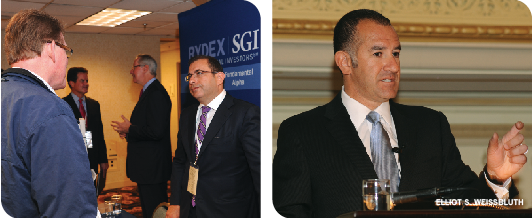From motion picture marketing and litigation funding to managed futures and private equity, the second annual Innovative Alternative Strategies conference sponsored by Financial Advisor and Private Wealth magazines covered the gamut from really alternative investment vehicles to more accessible alternative strategies.
More than 600 people attended the two-day conference, held in the grand ballrooms of the historic Palmer House Hotel in Chicago's Loop in late June. Over the course of 20 breakout sessions, panelists examined the ins and outs of various alternative investments and how to use them in client portfolios.
To kick off things, Rydex|SGI managing director Marc Zeitoun noted that Rydex surveys found 70% of advisors claim that alternative investments are a staple of their asset allocation process. He then laid out the basic reason why alternatives are appealing to growing numbers of financial advisors. "Alternatives' risk-mitigating strategies tend to lower the downside volatility in a client's portfolio. If they lower that downside volatility, the argument is the client wouldn't have a bad client experience and won't feel the need to change advisors."

In the past, Zeitoun noted, many people thought diversification was defined by the number of funds in a portfolio. "But post-2008, diversification has really evolved to the science of correlating asset classes, so now diversification is defined not by the number of different funds in a portfolio, but how do they interact," he said. "That's why we call it a judicious assembly of low-correlating assets because that's the science of portfolio management--reducing the risk for any market environment."
One of the fastest-growing alternative investment classes in recent years has been managed futures. As of December 2010, $266.8 billion was invested in the space, a more than tenfold jump since 1994. But many investors-and their advisors-are on a learning curve when it comes to deploying them in portfolios.
Managed futures are programs run by commodity trading advisors (CTAs) who are registered with the Commodity Futures Trading Commission. They manage client assets in proprietary programs that trade an array of futures contracts in hard and soft commodities, equity indexes, currencies and other assets.
Managed futures shined during the 2008 meltdown, as the industry's various indexes gained around 18% to 20% while the S&P 500 slumped 37%. The beauty of this asset class, proponents say, is that it invests in areas that have low correlation to traditional assets, such as stocks and bonds, to provide diversification to help mitigate investment risk.
 "The amount of diversification within the managed futures space is huge," said Brian Bell, research director at alternative asset manager Equinox Fund Management LLC. "We recently looked at the correlation of all of the managers in our products and found that 80% of them have daily correlations to each other of less than 0.4%."
"The amount of diversification within the managed futures space is huge," said Brian Bell, research director at alternative asset manager Equinox Fund Management LLC. "We recently looked at the correlation of all of the managers in our products and found that 80% of them have daily correlations to each other of less than 0.4%."
Bell said that since 1980 there have been 33 months when the S&P was down 5% or more, and during 79% of those months managed futures had positive performance.
Of course, managed futures aren't a panacea, and their lack of correlation to stocks and bonds can work both ways. "One of the struggles of managed futures is keeping people in the strategy when we're not performing at the peak when other assets might be," said Brad Weltler, regional director at Steben & Co. "2008 was obviously a great sales year for all of us in the space, but we lost money in 2009 when other assets went up. But that's the reason why you have strategies that react differently over different times. Advisors try to get clients from Point A to Point B with the least amount of risk, and you do that by allocating to different strategies. Managed futures can be a piece of that overall puzzle."
Regarding the allocation of managed futures, Weltler suggested they should comprise 15% of the equity portion of a portfolio. So in a 60-40 allocation, 15% of the 60% portion allocated to stocks-or 9% of the total portfolio-would provide the optimal risk reduction of the portfolio's equity component, he said.
An obscure alternative investment that was discussed at the conference is private life insurance. Private placement variable life insurance provides a tax-advantaged structure that maximizes investment values while providing significant life insurance benefits.
The vehicle offers exposure to a variety of asset classes, including alternative investments, within a life insurance structure. Investment gains accumulate on a tax-deferred basis while delivering an economic benefit upon the insured's death. Policyholder assets can be accessed through policy loans.
Another conference panel explored structured investments, which are notes or CDs with specific payout profiles based on the performance of a variety of underlying asset classes, and they are payable at maturity. Underlying assets can include equities, commodities, foreign exchange and products tied to the Libor rate that banks charge each other for loans.
Proponents say it's a way for investors to get exposure to various asset classes they normally might not have easy access to, and without holding the underlying securities. They also protect principal (upon maturity) and tailor risk to the individual investor.
Their risks include the credit risk of the issuer, their lack of transparency and a lack of principal protection until maturity. Also, they are complicated vehicles.
 Nonetheless, gross sales of structured investments in the U.S. are expected to grow 20% this year, according to Arete Consulting.
Nonetheless, gross sales of structured investments in the U.S. are expected to grow 20% this year, according to Arete Consulting.
The conference's featured speaker on the first day was Jeffrey Gundlach, CEO and CIO of DoubleLine Capital. Gundlach focused on macoeconomic issues, asserting that a huge change in government policy encompassing higher taxes and reduced entitlements is coming.
The featured speaker during lunch on the second day was Richard Bernstein, former chief investment strategist at Merrill Lynch and current CEO of Richard Bernstein Advisors LLC. He sprung a few fun facts on the audience, such as that the S&P 500 has outperformed equities in the BRIC countries of Brazil, Russia, India and China during the past three and a half years.
Bernstein, a noted pessimist during his last ten years at Merrill Lynch, which ended in 2009, sounded positive about the U.S. markets. For starters, he said, the U.S. has the steepest yield curve--which he noted is a major positive sign--and the strongest corporate profits among major economies. He acknowledged that the corporate sector has benefited disproportionately from the recovery even as Main Street has lagged, but he said U.S. companies are leading the world in revenue surprises (even if a lot of that comes from exports).
Bernstein was particularly bullish on U.S. small-cap companies. That didn't have anything to do with alternative investments, but then again, a well-diversified portfolio should include a range of asset classes.